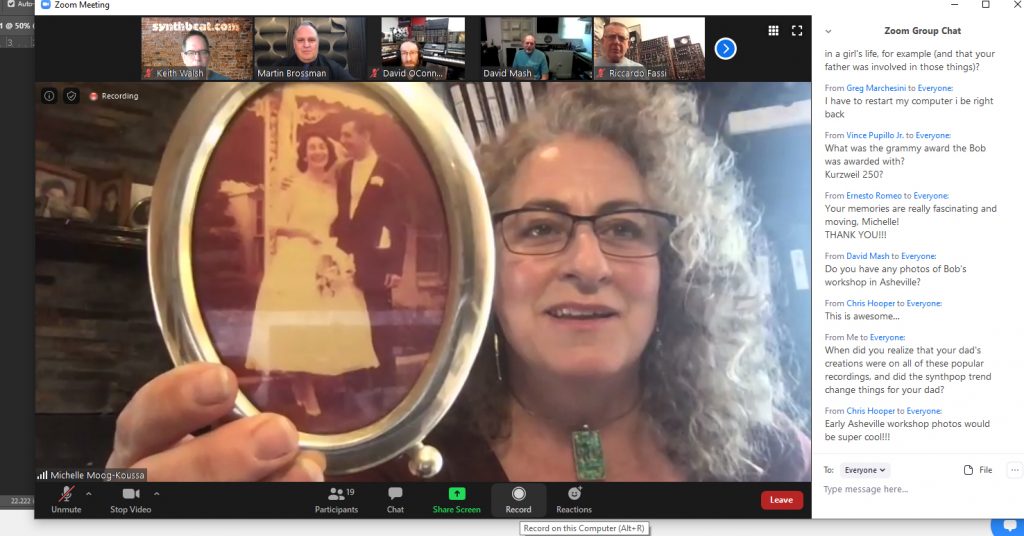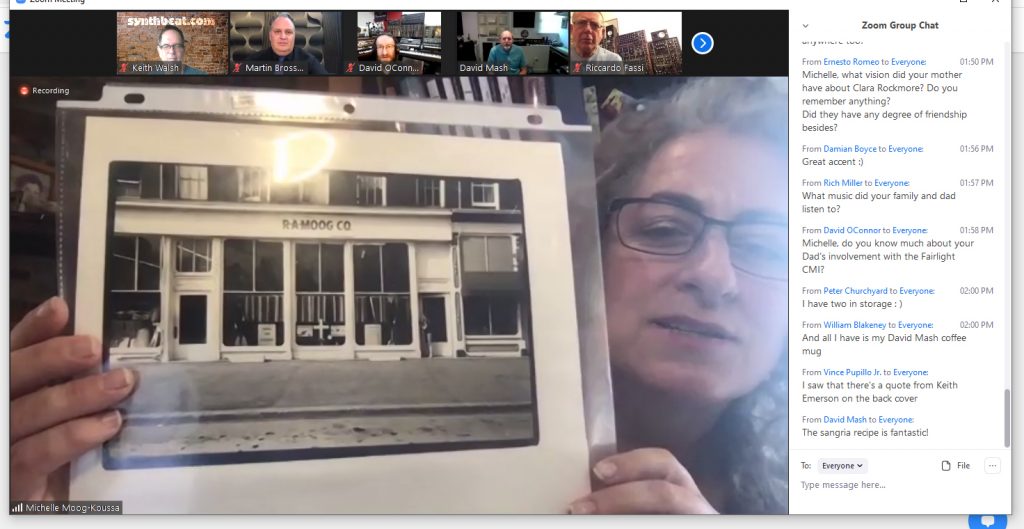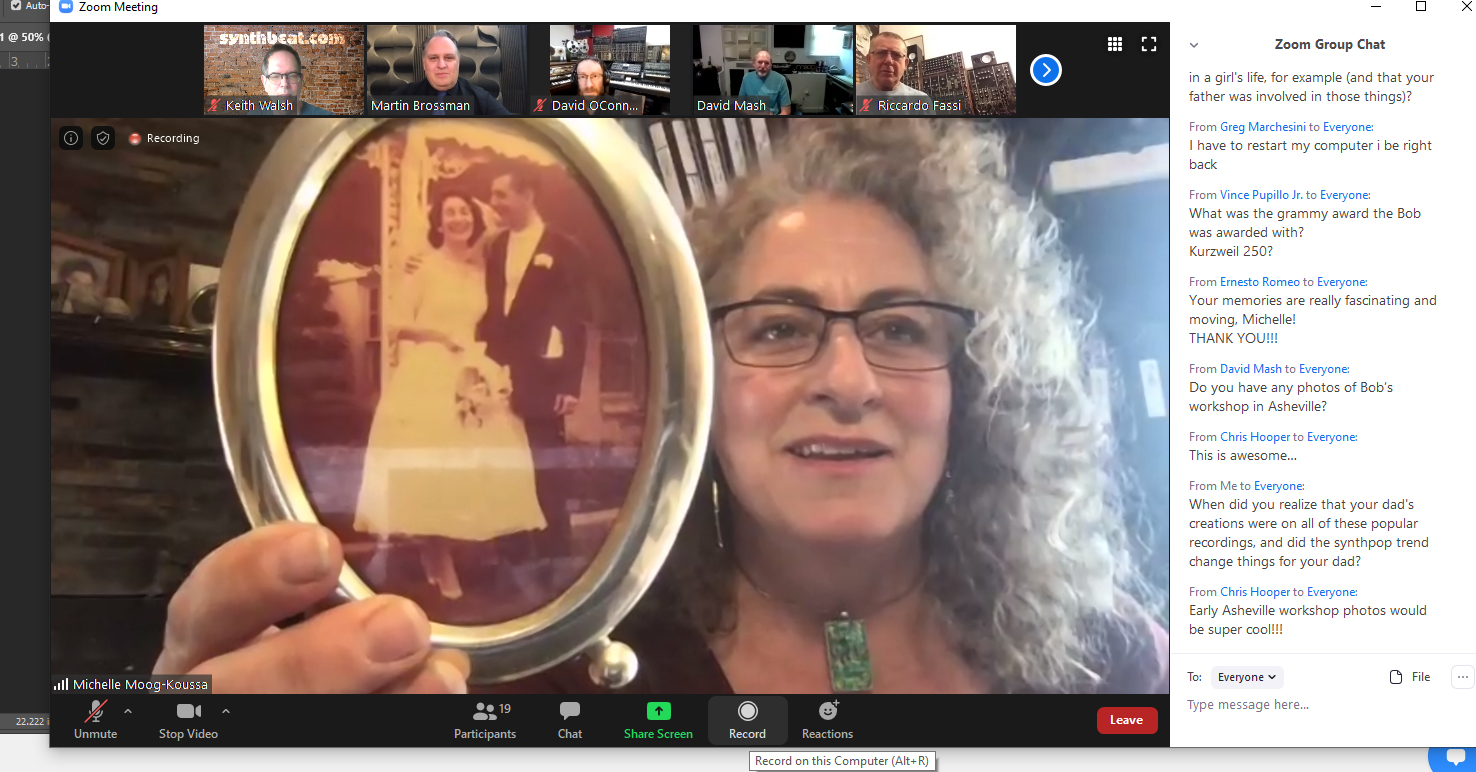By Keith Walsh
As a young girl, Michelle Moog-Koussa would hear strange noises coming from her father’s workshop.
When asked if she was intrigued by all of the electronic musical instruments that must have been around as she grew up as the daughter of electronic music pioneer Bob Moog, she said: “I was very intrigued. More than seeing them, I did hear them. And that was when I would go out to my dad’s shop, when we lived in North Carolina, ‘cause it was across the driveway, to give him a kiss goodnight. Because he always went to work after dinner. And I would give him a kiss goodnight, and there was a door, or there were two doors. You open the door to the workshop, and there was a big carpentry area, and another door that went into his electronics workshop.”
“And I would hear all these strange noises coming from that door, and I would just think, ‘what is he doing in there?’ But then I would sit there and listen, to him dialing in the sounds, making the sounds. Studying whatever was showing up on the oscilloscope. And I would wait until it stopped. And then I would go in and say good night. And it was never like people think, ‘oh did you climb up on your dad’s lap, and he taught you how to solder?’ Unfortunately, that’s not how it went. It was understood Dad was working, you went in there, you gave him a kiss goodnight, and you went to bed.”

May 23 is Bob Moog’s birthday. We were able to celebrate the life of this technological marvel with his brilliant daughter, who is running the Moog Foundation, on the eve of her father’s birthday, in a wonderful Zoom exchange, thanks to her efforts and those of Martin Brossman, with proceeds to benefit the Moogseum and The Bob Moog Foundation, in Asheville, North Carolina.
Contributions can be made to these important and valuable resources, at: https://www.paypal.me/BobMoogFoundation or at the Bob Moog Foundation’s website, at http://bit.ly/ContributeBMF.
Moog-Koussa shared numerous stories and photos of her dad’s life, including items like student awards and an “early aptitude for academics” shown on his report cards, as well as talking about his studies at Bronx Science High School and work in Electrical Engineering in a joint program with Queen’s College and Columbia University in New York. One of the most interesting nuggets to come from this meeting was an anecdote about how Bob Moog kept his business life separate from his family life, to the extent that Michelle didn’t really realize how influential or famous her father was for many years. The first time she got an inkling was when he appeared on the television show “To Tell The Truth.”
As Moog-Koussa explained, “My dad really did hold his career at arm’s length. And part of the reason that I’m not up here talking about the System 12, 15, 35, or discussing the ladder filter, is because, I didn’t know about any of that stuff until my father passed away. My father did hold his career at an arm’s length from us. I think that there were a variety of reasons that he did that.”
“One is, he was really uncomfortable with fame. And I think that he just wanted a place that he was ‘Bob,’ and ‘Dad’ and none of the other stuff was taken into consideration. I do think one of the reasons he was uncomfortable with his fame, is he felt, sometimes mischaracterized, as the guy who invented ‘the synthesizer,’ and he knew, of course, that that was an incorrect characterization. He invented the Moog synthesizer, there’s a big difference. He knew that he stood on the shoulders of giants and didn’t feel like those early pioneers got enough credit. When it came to his own work, he saw himself as someone who was more on the spectrum, rather than as someone who stood out.”
“The other reason is, quite honestly, my mother was a bit resentful of all the time that my dad spent at work, and so Dad didn’t talk about work that much around us.”
“To Tell The Truth”
The first time that Moog-Koussa really understood her father’s fame, it was by watching a national television program with her family.
“So the first time I realized that my dad was ‘Bob Moog’ was when I was about 5 years old,” she continued. “In 1972, there was a television game show in the United States called ‘To Tell The Truth,’ and for those of you who aren’t familiar, there’s a panel of celebrity judges, and then there’s someone who’s somewhat famous but not known to most people. And there are three people claiming to be that person. So when the show opens up, three Bob Moogs walk out. And one of them is Bob Moog, and two of them are not. And the judges, through a line of questioning, have to guess, who is the real Bob Moog.”
“So we were not allowed to watch very much television in my house, but at that time, we lived in Williamsville, New York, which is where the Moog Music Company was at the time, any my mother sat us down in front of the TV, which was in itself was unusual, because we knew Dad was going to be on TV. And as a little kid, that, I thought ‘why is Dad going to be on TV? –that seems really weird to me. Like, why is anyone’s dad on TV?’ But the way that the show went is that there was this line of questioning, and all of the judges guessed someone else, one other person. And then at the end, the announcer goes ‘Will The Real Bob Moog please stand up!’ And the three contestants kind of look at each other, and then my dad pops up with this huge grin on his face, ‘cause he was delighted that everyone thought he was lying. He got the biggest kick out of it.”

“A Different Lifestyle.”
I asked Michelle Moog-Koussa when she realized that her father’s instruments were featured in so many popular recordings.
“I did not realize that until I was a teenager,” she explained. “We lived in North Carolina, and the roadie from Toto came to our house, in the mountains, way in the middle of nowhere. Out comes this guy with long hair, and black leather. We live out, a five mile country road, up a third of a mile driveway, that was twisted, in a roundhouse, in the middle of 118 acres. And there’s some guy who belongs backstage in some arena. Or front stage even. And Chick Corea also came to visit us there. And at that point I didn’t know who he was. But I could tell that he lived his life in a different lifestyle than we did, with this flashy gold cigarette lighter. I know his habits are very different now, he’s a vegan and extremely fit and all of that. ”
“So that’s when I began to realize, and also, at that time I had another dawning because in ninth grade, I had a physical science class. You know, a kind of high school intro to science. And remember, we lived in the deep woods of North Carolina, and my family nickname was ‘Mimi,’ that’s what all my friends called me was well. And the first day of school, our teacher encouraged us, ‘here’s your textbook, and what I want you to do is flip through your textbook and I want you to get familiar with it, ‘cause this is what we’re going to be studying this year. So everyone dutifully opens the textbook, we’re flipping through it, and all of a sudden I hear someone say, ‘well there’s Mimi’s daddy!’ Part of my brain blacked out and the rest of it was probably ‘what?’ So I turned to page whatever it was and there was my dad staring up at me. And it was at that time that I began to listen to some pop music, so I began to recognize that the Moog synthesizer was an important voice in some of the music that I was listening to.”
I also asked “did the synthpop trend change things for your dad?”
“You know, I don’t think it changed things much for him then. Because if we’re talking synth pop, and correct me if I’m wrong, I’m thinking early ’80s. By that time, Dad left Moog Music by the end of 1977. 1978, six months later we moved to North Carolina, and the reason it was June of 1978 is because my mother was protective of her little Minimoogs, and she would never allow Dad to move us before the end of a school year. So we moved in June of 1978, and Dad started Big Briar. He was building electronic musical instruments, like the MTS keyboard for John Eaton, which was another love of his. The keyboard, not John, although he loved John too.”
“But he started out making alternative controllers. He was really interested at that point in not synthesis itself, but he felt that the keyboard was an antiquated interface, it was too limiting, and he wanted to develop other ways that synthesis could be accessed. I think he felt that it wasn’t reaching its full potential through a traditional keyboard. So he made a theremin interface, he developed a small multi touch sensitive interface, and he developed a whole line of theremins. And that went on through the end of 1984 when we moved to Boston for him to work at Kurzweil. And when he came back, he started teaching, and then analog started coming back. And he was making theremins again but also working on Moogerfoogers. So I don’t think it affected him directly, although I’m sure he was interested to see this kind of new genre to pop up. And it certainly affected the company that was still going at that time.”
This article only touches the tip of the iceberg of the fascinating story of Bob Moog and Moog synthesizers. Stay tuned for more.

It was a great moment and a big honnor for the Moog Fan Club
to have that kind of event with Michelle Moog Koussa .
tks to all the people that came on Zoom for that event and stay toon cause i hop we are going to that again =)
It sure was Greg. It was super special.Great to hear Michelle’s insights and stories.